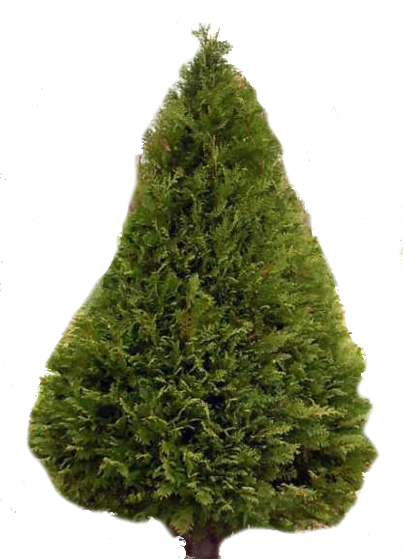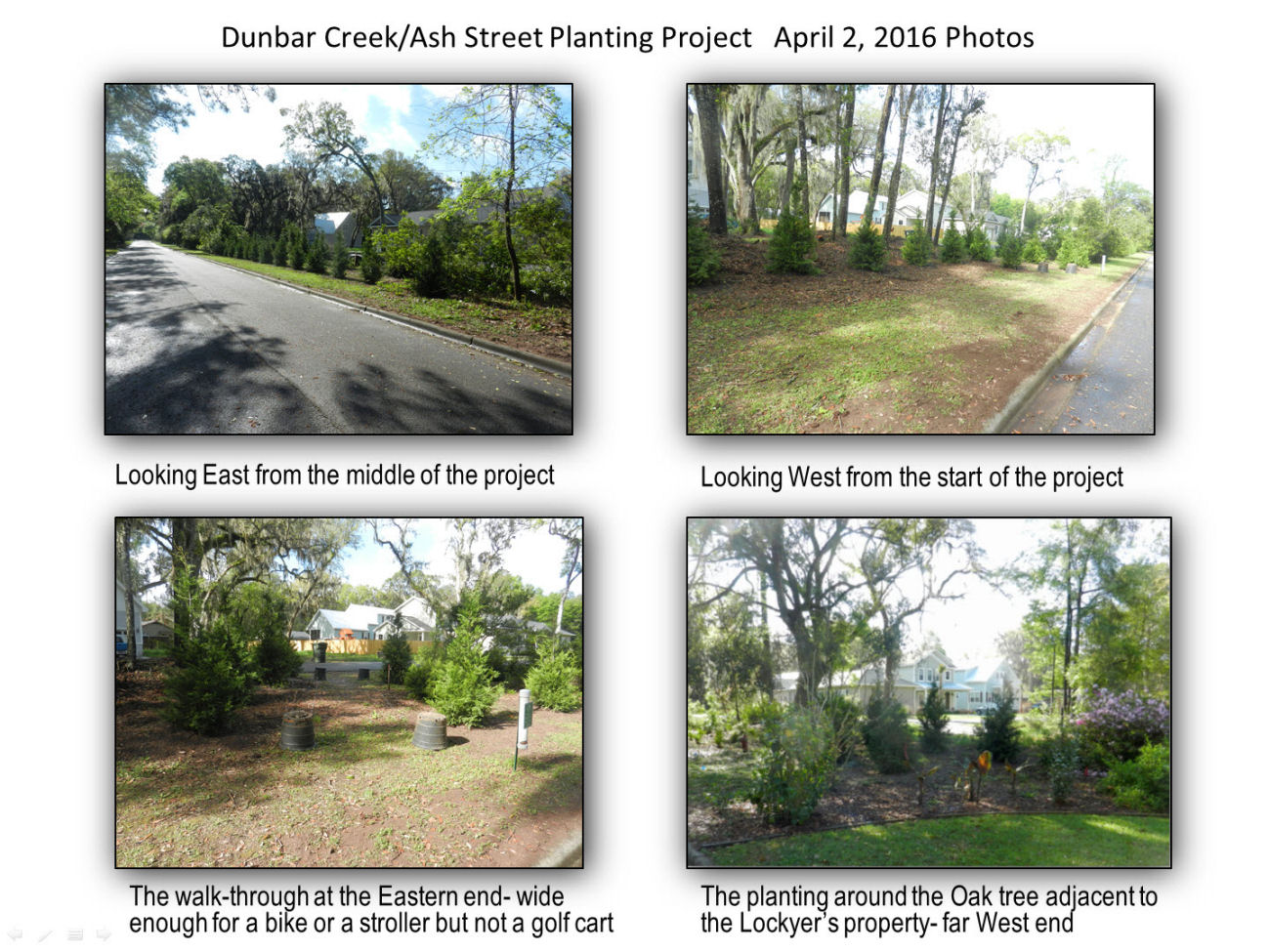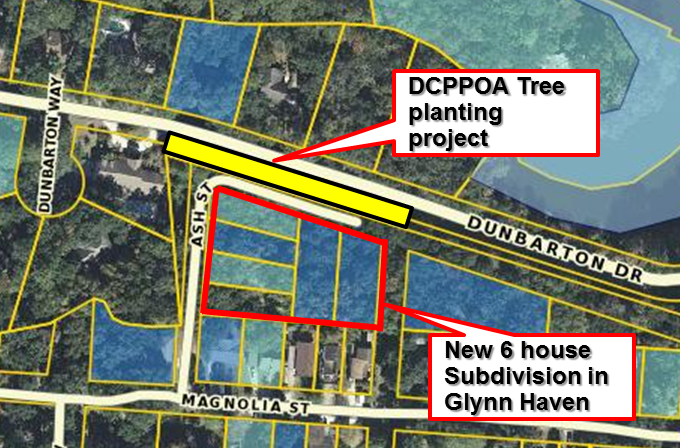DCPPOA Tree Planting Dunbarton Drive/Ash Street |
|
At the 2016 Annual Membership Meeting held February 7, 2016 one of the items of discussion was the design and planting of a barrier between Dunbarton Drive and Ash Street in the area where the new Glynn Haven subdivision has been built. Since Dunbar Creek Plantation was built the residents enjoyed the natural barrier that separated the two subdivisions. The area, once owned by the Hammock family, was sold and the natural barrier was clear cut to build 6 homes on the property. The Island Planning Commission approved the site plan and did not require the builder to maintain any buffer- they clear cut to the property line. We met on-site with the Glynn County District 2 Commissioner, Dale Provenzano to discuss the situation. He said the project had been approved and there was nothing that could or would be done. In essence Ash Street was paved, parallel to Dunbarton Drive and merely 40 feet away. In reality Ash Street was on the books before Dunbarton Drive (but prior to the sale it was never actually anything but a series of lines on a map- it existed in a wooded, unimproved lot). To not require the developer to leave a barrier strip was hard to fathom. To our neighborhood It was an example of poor planning at it's best. We think it would be difficult to find anything in a best practices manual for community development that would have one road 40 foot from the other (unless it was perhaps a major highway), without a required barrier between the subdivisions. The problem with Planning committee's is they never walk the property or pay much attention to the neighbors around the parcel and how it affects them. Somehow in Georgia, ones right to do with their property as he or she pleases, trumps the rights of others. |
Simply speaking, it was our issue to resolve. At the Annual meeting a Tree Committee was appointed to study the issues, raise funds and decide what should be planted and where. The committee included Jim Fraser, David and Linda Usrey, Bobby and Karen Young, Ed Craighill, Barbara Pelletier and Paul Lockyer.
In earlier conversations with the County, David Hainley, Community Development Director agreed to develop a landscape plan. He met with the Committee on-site to get initial guidance and measure the area. DCPPOA owns a planting strip that runs parallel to Dunbarton Drive, between us and Ash Street. The strip runs from Lockyer's property on the West line to the pump house and the edge of the Meyer's property line on the East. |
|
|
In our original discussions we fully intended to plant primarily the Leyland Cypress trees. They grow fast and can reach heights of 40-50 feet with a diameter of approximately 16 ft. They are often used as a barrier tree by landscapers. Our research indicated that the Murray Cypress was a better alternative. It grows faster, is more disease resistant, has stronger branches and is greener than the Leyland. The Murray Cypress is quickly becoming the tree of choice for the Georgia Christmas Tree Industry. After additional research and discussion it was agreed that the Murray Cypress would be the major tree for our tree planting program. We also agreed to supplement the native Saw Palmettos under the large Oak tree by adding 17 plants. |
One of our goals was to keep as much of the present vegetation as possible. We had some quality native Wax Myrtles and the trees would be planted in a way that would supplement these plants. In our original plan we considered planting seedlings. That idea was abandoned in favor of larger, more mature trees. A Grower was located in Watkinsville, GA who could furnish us 15 GAL, 6- 7 foot trees at a very reasonable price. The landscape plan developed by David Hainley in conjunction with the committee called for 54 Murray Cypress and 17 Saw Palmetto plants. The landcape plan is below. |
|
LANDSCAPE PLAN LEGEND
The RED areas are in-place Wax Myrtles, the RED dot with a BLACK border to the right in the plan is a standing Oak tree, the GREEN circle with a BLACK dot represents the to be planted Murray Cypress trees and the WHITE dots with a BLACK border represent the Saw Palmettos to be planted. The four RED dots with a Black border on the left represents in-place trees. These trees were covered with extensive vine growth which stunted their growth. The majority of those vines; the ones which were reachable, have been removed. The rest will die a natural death.
|
The committee initially had desired to have the entire planting and landscaping done professionally. The three bids that came back were all in excess of $ 11,000 and that figure did not include an irrigation system- the irrigation system was was considered essential in the early life of these trees and plants- especially when one considers there is always the potential for long hot summers with limited or no rain. After considering a number of options it was decided that connecting together two already installed systems drawing from the lake was the cheapest and most effective alternative. This provided an unlimited water source. This would require connecting the two system together (the Usrey's and Pelletier's), running PVC from their backyards to the street, tunneling under the street, installing a larger controller and installing pipe and sprinklers for the approximately 350 foot project (the frontage of the project). The connection of the two systems and the tunneling under Dunbarton Drive was completed on March 26, 2016. The spinkler systems will be installed by March 31, 2016. The total sprinkler system cost was $ 1950. |
 |
A Murray Cypress Tree-
also
known as a Murray-X |
|
Just prior, on March 28, 2016 David Usrey and his son drove to Watkinsville, GA with a 20 foot trailer in tow to pick up the 54 Murray Cypress trees; returning on the same day ( a 12-hour round trip). We sincerely appreciate their gracious effort in this endeavor. We were able to purchase the 54 trees for $ 2600. It will cost about $600+ to plant the trees. The parallel effort was a cleanup of the area and the removal of a significant number of vines and weeds.The cost for the cleanup and hauling off of the debris was $ 450. As you can obviously see this has not been a cheap project and it is not done yet. Our quest for additional donations continues. As of this date 20 of 59 residents have graciously contributed. We will still need additional funds to make this the superior neighbor- hood project it is destined to be. |
The difficulty with a project like this is if you don't live near it or pass by it every day it doesn't appear to be of great concern to you. From our perspective this could not be further from the truth- this project will indeed enhance our whole neighborhood and influence everyone's property values. When property is appraised the entire neighborhood is considered. When someone considers buying a house they always drive down the street to see what the remainder of the neighborhood looks like and what they see influences their final buying decisions. We have also decided if we somehow get donations that are greater than required for this specific project we will use those funds to clean-up and enhance the common area around the lake. |
On Tuesday, March 29, 2016 the first 19 trees were planted and the walk-through layed out. The irrigation system was operational and watered the new trees. On April 1, 2016 the remainder of the Murray Cypress trees were planted as well as 17 Saw Palmettos and 5 Anis bushes. If the funds are available- the area will be covered with Pine Straw. Prior to putting down the Pine Straw we intend to cover the area with wet newspapers. This will retard weed growth and the paper, being a wood product, will deteriorate within a year. Good use of recycled materials. The placing of the wet newspapers will be a community effort. Save your newspapers and be prepared to join us in placing them on the ground. |
Below you find a concept drawing of the completed project. |

|
This is a composite photo of the project on April 2, 2016 |

|
What happens next is largely a product of monies and that comes from resident donations. At this point only a little over a third of the residents have donated. The rest have been contacted and we await their response. The concern of the association leadership is always- do they see this as a neighborhood project or do they see it as being just for "those folks who live down the street"? This area is at the back half of our development. If it was at the front end, and everyone had to drive by everyday, the response may be quite diferent. It tends to be out of sight out of mind.
We have done everything possible to make this truly a community project. It is always difficult to instill a sense of community and ownership. That is almost always true of volunteer organizations. It is very similar to attempting to get individuals to serve on the Board of Directors. They don't often see it as being their responsibility because they know others will step up . . . just as they have in the past. The same "go to people" not only have to share their portion of the load- they often have to pick up for their neighbors who for whatever reason . . . they simply do not have a sense of obligation to pay their fair share. Hopefully we will see a breakthrough and additional residents will step up to the plate and share the financial burden of this worthwhile community project. |




